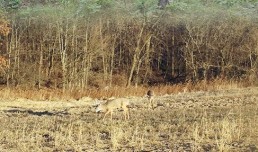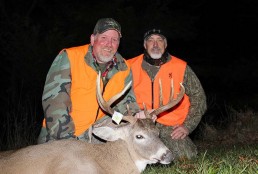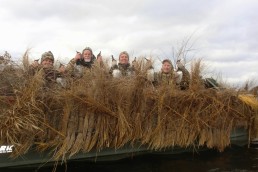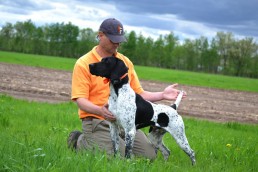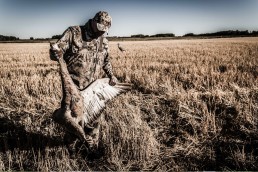Pressure’s On: How Hunting Affects Buck Movement
SHARE THIS POST
It’s accepted that deer behavior and deer sightings change after hunting season opens and many flock to the field. Hunting puts pressure on deer, and after they recognize that pressure, their pattern of movements change. Bucks will go to great lengths to avoid contact with humans.
Few studies have monitored the extent that hunting activities affect deer movements. However, Mississippi State University Deer Lab (MSUDeerLab.com) in south-central Oklahoma conducted one recently.
The main objectives of the study were to determine the affect of hunter activity (density) on movement patterns and habitat selection of white-tailed deer during the season.
“Older bucks were targeted for the research, as they are typically the most evasive,” said Dr. Steve Demarais, MSU Deer Lab professor, from information and data obtained from the study.
There is a science behind the theory, and here are the details on the study and results, along with some conclusions that can be derived:
The setup
The Oklahoma study was conducted on a 4,600-acre piece of property. Monitoring hunter density, the area was divided into three hunting pressure zones: no-risk (no hunting zone), low-risk (one hunter per 250 acres) and high-risk (one hunter per 100 acres). Each zone had forested areas, open grasslands and mixtures of open areas with an overhead canopy.
A total of 37 bucks from 2 1/2 to 6 1/2 years of age (with 3 1/2 the average age) were captured using drop nets and dart rifles. They were sedated, ear tagged and affixed with GPS radio collars. A location for each buck was recorded every eight minutes during the hunting season.
The Oklahoma gun season was the time span being monitored and lasted 16 days. The season was broken into the initial risk period (first three days) and the prolonged risk (the remaining days) period. Along with GPS locations of bucks, hunter density was recorded as deer harvests and sightings were reported by the hunters.
The study was conducted over a two-year period, encompassing two Oklahoma gun seasons. The risk zones alternated between the years on the same property, when the first year’s no-risk became the second year’s high-risk, and the first year’s high risk became the second year’s low risk, etc.
The results
The no-risk zone was used as the “standard” for the study. The bucks in this area were undisturbed and saw no hunting pressure whatsoever. Their locations and patterns of movement were used to compare with the other two risk zones.
The most interesting results of the study showed in the low-risk zone (one hunter per 250 acres), where there was minimal effect on deer movement. It was virtually the same as the no-risk zone. Buck movements across this area remained in a more linear pattern and covered very similar distances as the no-risk zone. They frequented open and mixed areas similar to no-risk zone bucks.
Are you enjoying this post?
You can be among the first to get the latest info on where to go, what to use and how to use it!
However, in the high-risk zone (one hunter per 100 acres), the deer recognized hunting pressure within three days, the initial risk period. Deer harvest went down after opening weekend and deer sightings declined 62 percent.
The collared bucks in the high-risk zone still traveled the same distances as bucks in the low- and no-risk areas. However, the complexity of their paths increased, meaning they made more “use” of less area—they didn’t cross as much of the property when there was greater hunter density, decreasing movements across open spaces and using non-pressured pockets more intensely.
When the bucks recognized pressure in the high-risk area, they began to use wooded forest areas and abandoned open areas, for the most part. They adapted to hunting pressure and used cover for security. Buck sightings and harvest decreased with exposure. The deer were unable to recognize when hunters left the area, so this activity was both day and night.
The data also shows that the bucks moved less during the prolonged risk period (after the initial three days). Compared to the initial risk period, they moved 17 percent less during the daytime and 31 percent less at night.
Conclusions drawn
Data and analysis of the deer study show us a few important things about mature buck response to recreational hunting:
- Deer recognize increased hunting pressure within three days.
- The use of cover increases as bucks perceive hunting pressure.
- Deer are unable to know when hunters leave the area at night.
- Buck sightings and harvests decrease with exposure to hunters.
- Deer travel routes change from a more linear path to a more complex one. They will move the same distances as low-risk areas, but will use less space.
- Where pressure is one hunter (or less) per 250 acres, there’s little impact to deer movement.
What’s a hunter to do?
If you can hunt places that are similar to the low-risk area, you’re fortunate. However, you still have to hunt smart and play the wind—always. You can stay with your established stands and expect results on grounds with minimal hunting pressure.
Then there are the rest of us who have to deal with hunting pressured areas.
“Don’t sit in the same blinds and expect bucks to come to you after opening weekend,” Dr. Demarais said. “You have to get out to their location where there is less area that they are using more intensively.”
Be mobile and hunt the trails, bottlenecks and pinch points in the terrain. Keep the wind to your advantage, not only while up in the treestand or in the ground blind, but also when entering or exiting your hunting area.
For more information…
Check out the Deer Lab’s new app that’s available on the Apple and Android App stores by searching for MSUES Deer Hunt. It’s a free app designed to provide services to hunters for their own data collection. The Deer Lab has just started another study very similar to the Oklahoma study, covering a 40,000-acre area targeting 50 mature bucks. This particular study will take three years to complete. It will be interesting to see the results, and we will report on it here in the pages of MidWest Outdoors.
MWO
SHARE THIS POST
Did you enjoy this post?
You can be among the first to get the latest info on where to go, what to use and how to use it!
Andy Douglas
Andy Douglas is an avid hunter, outdoor writer, and photographer. He has been chasing whitetails, big toms, bass, and most game that can be had for over 35 years. He lives the outdoor lifestyle and is passionate about sharing with others through stories and photos. Email him at AndyDouglas.Outdoors@yahoo.com
